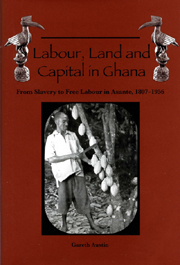Book contents
- Frontmatter
- Contents
- List of Illustrations
- List of Tables
- Preface
- Note on Names
- Maps
- Note on the Maps
- 1 Introduction
- Part I Context and Concepts
- Part II Social Relations of Production and Trade, 1807–1896: Absent and Imperfect Factor Markets
- Part III Slavery as Hobson's Choice: An Analysis of the Interaction of Markets and Coercion in Asante's Era of ‘Legitimate Commerce’, 1807–1896
- Part IV The Decline of Coercion in the Factor Markets of Colonial Asante: Cocoa and the Ending of Slavery, Pawnship and Corvée, 1896–c.1950
- 11 Why Was Prohibition So Long Delayed? The Nature and Motives of the Gradualism of the British ‘Men on the Spot’
- 12 The Decline of Coerced Labour and Property in Persons in Practice: Change from Above and from Below in Colonial Asante, 1896–1950
- 13 Cocoa and the Ending of Labour Coercion, c.1900–c.1950
- Part V Social Relations of Production and Trade, 1908–1956: Towards Integrated Factor Markets?
- Part VI Freedom and Forest Rent, 1908–1956
- Abbreviations Used in the Notes
- Notes
- List of References
- Index
11 - Why Was Prohibition So Long Delayed? The Nature and Motives of the Gradualism of the British ‘Men on the Spot’
from Part IV - The Decline of Coercion in the Factor Markets of Colonial Asante: Cocoa and the Ending of Slavery, Pawnship and Corvée, 1896–c.1950
Published online by Cambridge University Press: 12 September 2012
- Frontmatter
- Contents
- List of Illustrations
- List of Tables
- Preface
- Note on Names
- Maps
- Note on the Maps
- 1 Introduction
- Part I Context and Concepts
- Part II Social Relations of Production and Trade, 1807–1896: Absent and Imperfect Factor Markets
- Part III Slavery as Hobson's Choice: An Analysis of the Interaction of Markets and Coercion in Asante's Era of ‘Legitimate Commerce’, 1807–1896
- Part IV The Decline of Coercion in the Factor Markets of Colonial Asante: Cocoa and the Ending of Slavery, Pawnship and Corvée, 1896–c.1950
- 11 Why Was Prohibition So Long Delayed? The Nature and Motives of the Gradualism of the British ‘Men on the Spot’
- 12 The Decline of Coerced Labour and Property in Persons in Practice: Change from Above and from Below in Colonial Asante, 1896–1950
- 13 Cocoa and the Ending of Labour Coercion, c.1900–c.1950
- Part V Social Relations of Production and Trade, 1908–1956: Towards Integrated Factor Markets?
- Part VI Freedom and Forest Rent, 1908–1956
- Abbreviations Used in the Notes
- Notes
- List of References
- Index
Summary
For students of the relationship between rhetoric and action the most striking fact about colonial policy on slavery in West Africa is that the administrations in the various colonies mostly took years before implementing the commitments of their respective empires to end slavery and human pawning within their borders—on the face of it, bearing out the scepticism of dependency theory about imperialism as a promoter of ‘modern’ capitalist relations of production. When British forces occupied Asante in January 1896 slave-owning had already been illegal in the British colonies in the West Indies and South Africa since 1834. In India and the Gold Coast the legal status of slavery (slavery as an enforceable property-right) had been abolished in 1870 and 1874 respectively. Yet it was not until June 1908 that slavery was prohibited in Asante.
The reasons most commonly advanced for the gaps between international and parliamentary commitments, on one hand, and policy in West Africa, on the other, are that officials believed that abolition would disrupt the colonial economies and create, simultaneously, rootless proletariats and angry and enfeebled indigenous political elites. This would undermine order and the system of ‘indirect rule’, and promote criminality and political dissent or rebellion, thus putting greater strain on colonial resources. This chapter uses the detailed documentation in the national archives in Kumasi to analyse the colonial decision-making process as a test of the existing general explanations for colonial caution about the emancipation of slaves and pawns.
- Type
- Chapter
- Information
- Labour, Land and Capital in GhanaFrom Slavery to Free Labour in Asante, 1807–1956, pp. 205 - 214Publisher: Boydell & BrewerPrint publication year: 2005

